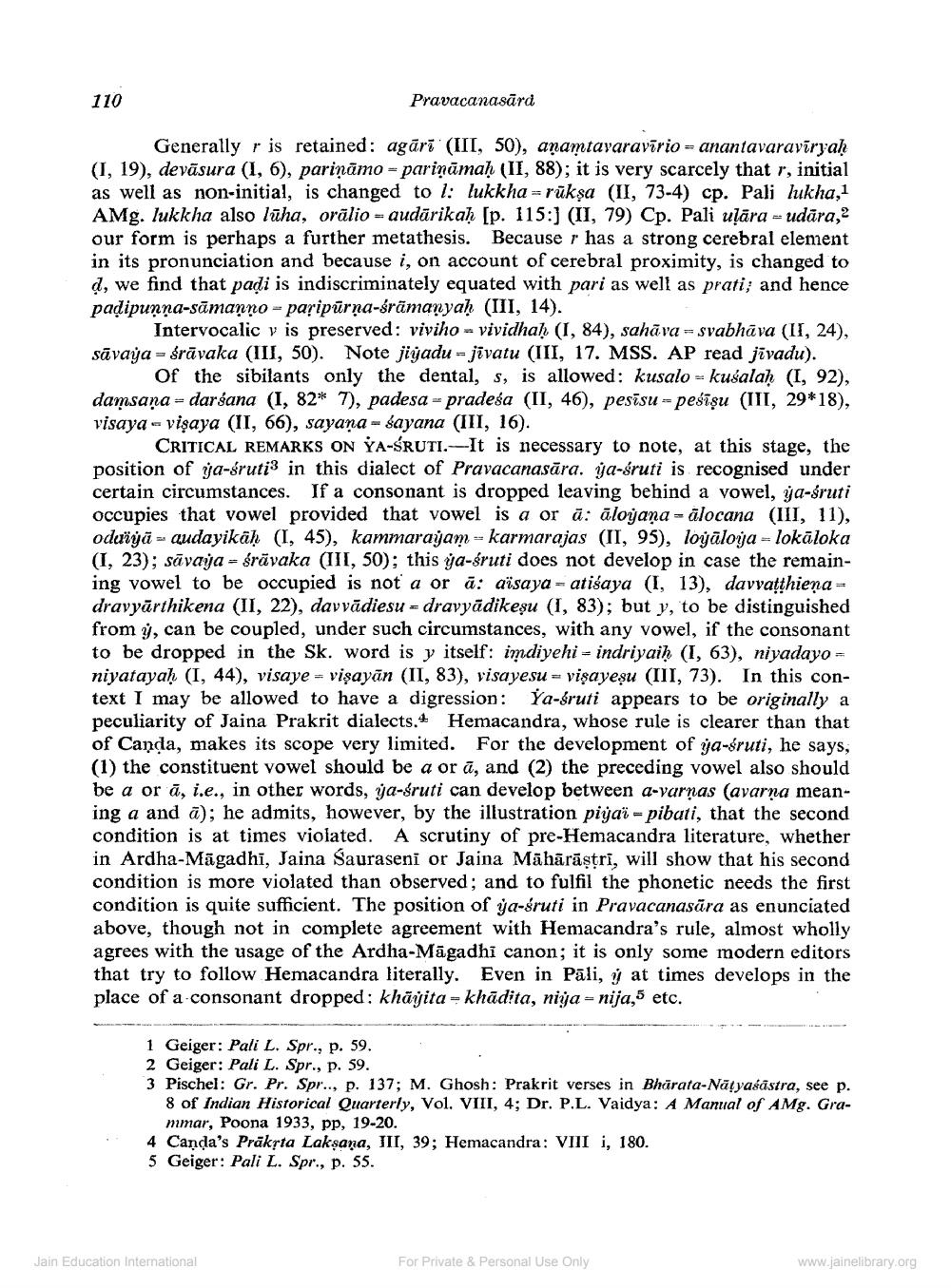________________
Pravacanasārd
Generally is retained: agārs (III, 50), anamtavaravirio-anantavaraviryaḥ (I, 19), devāsura (1, 6), pariņāmo - pariņāmaḥ (II, 88); it is very scarcely that r, initial as well as non-initial, is changed to : lukkha-rükṣa (II, 73-4) cp. Pali hukha,1 AMg. lukkha also luha, oralio-audarikaḥ [p. 115:] (II, 79) Cp. Pali ujāraudāra,2 our form is perhaps a further metathesis. Becauser has a strong cerebral element in its pronunciation and because i, on account of cerebral proximity, is changed to d, we find that padi is indiscriminately equated with pari as well as prati; and hence paḍipuṇṇa-samayyo-paripürya-bramanyah (III, 14).
Intervocalic v is preserved: viviho- vividhab (1, 84), sahāva-svabhāva (II, 24), sāvaja - árāvaka (III, 50). Note jigadu-jivatu (III, 17. MSS. AP read jivadu). Of the sibilants only the dental, s, is allowed: kusalo kušalaḥ (I, 92), damsaṇa-darśana (I, 82* 7), padesa-pradesa (II, 46), pesīsu-pešīzu (III, 29*18), visaya - vişaya (II, 66), sayaṇa-bayana (III, 16).
CRITICAL REMARKS ON YA-ŚRUTI.-It is necessary to note, at this stage, the position of a-ruti3 in this dialect of Pravacanasāra. jja-śruti is recognised under certain circumstances. If a consonant is dropped leaving behind a vowel, ga-sruti occupies that vowel provided that vowel is a or a: alojaṇa-alocana (III, 11), odalgā - audayikäḥ (1, 45), kammarajam-karmarajas (II, 95), logaloja - lokāloka (I, 23); sāvaja-krāvaka (III, 50); this ja-sruti does not develop in case the remaining vowel to be occupied is not a or a: alsaya-atikaya (I, 13), davvatthieṇadravyarthikena (11, 22), davvädiesu-dravyädikegu (1, 83); but y, to be distinguished from ý, can be coupled, under such circumstances, with any vowel, if the consonant to be dropped in the Sk. word is y itself: imdiyehi - indriyaih (1, 63), niyadayoniyatayaḥ (1, 44), visayeviṣayān (II, 83), visayesu- viṣayesu (III, 73). In this context I may be allowed to have a digression: Ya-śruti appears to be originally a peculiarity of Jaina Prakrit dialects, Hemacandra, whose rule is clearer than that of Canda, makes its scope very limited. For the development of yja-śruti, he says, (1) the constituent vowel should be a or a, and (2) the preceding vowel also should be a or a, i.e., in other words, ya-éruti can develop between a-varnas (avarna meaning a and a); he admits, however, by the illustration piya-pibati, that the second condition is at times violated. A scrutiny of pre-Hemacandra literature, whether in Ardha-Magadhi, Jaina Saurasent or Jaina Mähäräṣṭri, will show that his second condition is more violated than observed; and to fulfil the phonetic needs the first condition is quite sufficient. The position of ja-iruti in Pravacanasara as enunciated above, though not in complete agreement with Hemacandra's rule, almost wholly agrees with the usage of the Ardha-Magadhi canon; it is only some modern editors that try to follow Hemacandra literally. Even in Pali, ý at times develops in the place of a consonant dropped: khāÿita = khādita, niya - nija,5 etc.
110
1 Geiger: Pali L. Spr., p. 59.
2 Geiger: Pali L. Spr., p. 59.
3 Pischel: Gr. Pr. Spr.., p. 137; M. Ghosh: Prakrit verses in Bharata-Nāṭyaśāstra, see p. 8 of Indian Historical Quarterly, Vol. VIII, 4; Dr. P.L. Vaidya: A Manual of AMg. Grammar, Poona 1933, pp, 19-20.
4 Canda's Prakṛta Lakṣana, III, 39; Hemacandra: VIII i, 180.
5 Geiger: Pali L. Spr., p. 55.
Jain Education International
For Private & Personal Use Only
www.jainelibrary.org




